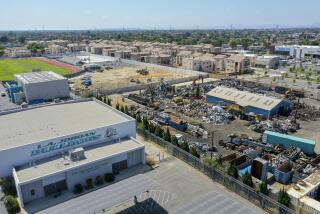Space Project Fails to Shape Up : Former Students’ Plan to Melt Metal Fizzles When Thermostat Fails
- Share via
Jeff Craddock and his fellow Cal State Northridge engineering school alumni went to great lengths to carry out what had begun as a student project--all the way into space.
In pursuit of their elusive, but scientifically significant, goal--converting little metal pellets into perfect spheres--they spent almost seven years working nights and weekends assembling an automated experimental apparatus, contributing their own time and money. They struggled with mountains of paperwork and a jungle of government bureaucracy to get their project into orbit aboard a space shuttle in June.
When they finally got the experiment back from the space shuttle Columbia, what did they find?
Little metal pellets.
The same ones they sent into space, unchanged.
“It was very, very painful when we went down to the cape to pick up the experiment,” Craddock said in his office at Rockwell International’s Rocketdyne Division, where he is a design engineer. “We knew almost right away that something had gone wrong.
“Our hearts just sank.”
A thermostat shut down the heating element in the battery-powered experiment long before the metal pellets--suspended in wax--were hot enough to melt, he said.
The experiment was begun in 1984 by Craddock and about a dozen other students as a Cal State Northridge engineering school project. It was designed to determine whether metal that melted in space--where it could float in zero gravity--would contract into perfect spheres, as theoreticians believe. Perfect spheres could be used as high-efficiency ball bearings, which now--because of the distorting effects of gravity on Earth--are always imperfect in some way, if only microscopically slight.
“When we picked up the experiment, I immediately got out the tape from the little on-board computer so that I could read the data. Everything started out just perfect, the experiment started heating up just at the time it was supposed to during the flight.”
The thermostat was not supposed to open up, breaking the electrical circuit to the heating element, until the temperature inside the payload reached 240 degrees Fahrenheit, by which time the metal would have melted.
“The temperature was climbing up and up until it hit about 95 degrees, and then the line on the readout just flattened out,” he said. “We still don’t know why the thermostat opened up and stopped it.”
The thermostat had worked perfectly in tests on Earth, he said, and X-rays taken of it after the flight did not reveal any abnormalities. It has been shipped to the manufacturer for tests.
“At this point, we don’t know if the part was faulty or if there was something in our system that made it go wrong,” he said.
Craddock, 37, said members of the team--which had dwindled to four over the years as the originators of the project went their separate ways after graduating--are not sure if they will try to correct the problem and get the experiment space-bound again. It is important work, Craddock said, because it could point the way to creation of factories on space stations to manufacture super-efficient ball bearings.
The experiment has cost the students and their handful of sponsors about $10,000, not to mention uncounted hours of contributed labor, and getting a new experiment into space would cost an additional $6,000, Craddock said.
“We will know more when the report on the part comes back in a few weeks,” Craddock said with a sigh. “Then we’ll have to figure out if we want to do this again.”
More to Read
Sign up for Essential California
The most important California stories and recommendations in your inbox every morning.
You may occasionally receive promotional content from the Los Angeles Times.














